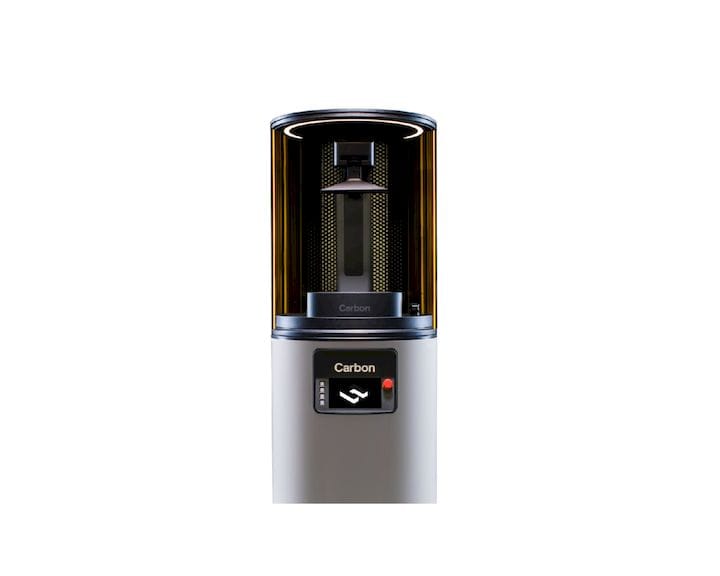![Carbon’s new M2d dental-focused 3D printer [Source: Carbon]](https://fabbaloo.com/wp-content/uploads/2020/05/image-asset_img_5eb09c356a12b.jpg)
Carbon’s powerful resin 3D printers have been extensively used by manufacturing, but it seems the company is all in for dental usage as well.
Carbon issued a slew of announcements focused on the dental 3D printing industry, covering not only hardware, but software, materials and process. It seems their aim is to cover both large-scale and small dental manufacturing operations with these developments.
But what did they announce? Where shall I start, there’s so much? Let’s start with hardware.
There is a new Carbon 3D printer, the M2d (seen at top), which seems to be a variant of their popular M2 machine. It’s apparently fitted with a smaller build volume than the M2, which enables smaller dental manufacturing operations to make use of the technology.
The M2d also offers the ability to upgrade to a larger build volume later, should the need arise. This is quite interesting, as I am wondering whether this is a physical upgrade, or merely a software tweak that enables more movement on the axes. If it s a software move, that is a very interesting development from Carbon, as it allows them to essentially continue manufacturing one type of machine, but make two different machines simply through software. It also reduces the need for upgrade hardware and labor, should upgrades be requested.
Carbon also announced a new “Smart Print Washer” to accompany the M2d. This device is tuned for cleaning dental prints quickly and efficiently.
![The new Smart Part Washer [Source: Carbon]](https://fabbaloo.com/wp-content/uploads/2020/05/image-asset_img_5eb09c359625a.jpg)
A very interesting development is their new “C6” cassette. This accessory is available for their M2 device, and enables double-speed 3D printing. I’m not quite sure how this technically works, but the results could be quite significant for some dental operations.
For example, if you were to switch to the C6, it is financially equivalent to buying another M2 device! Twice the output from the same machine. I’m not sure if this could dent Carbon’s sales, but a very useful accessory for dental operations indeed!
For larger dental operations, Carbon announced their “L1 Production Solution for clear aligner models” offering. This is a comprehensive bundle of printer (their L1 device), hardware, software and processes that implement a “factory in a box”, as they describe it, specifically for producing clear aligners.
![The Carbon L1 3D printer [Source: Carbon]](https://fabbaloo.com/wp-content/uploads/2020/05/image-asset_img_5eb09c35bd2bf.jpg)
Aligners are perhaps the most frequently 3D printed object in the dental world, so having a solution specifically focused on that product could be a significant advantage to Carbon.
Let me tell you how comprehensive this solution is: not only does the solution include real-time digital tracking of all activities, they even include custom racks for prints. I can literally imagine this package being rolled into an empty room and being used to set up a working factory in short order.
In my experience, if you want something to happen, make sure it is easy. It seems that Carbon is using that same philosophy here, as the ease of use will certainly attract many buyers.
Carbon announced support for four third party resins. Honestly, I was not aware that Carbon did allow support for third party resins, but I’m pretty pleased to see they do. It’s always difficult for a major company to keep up with materials developments when competing with other smaller and more nimble material specialist firms able to crank out unusual materials far more rapidly.
The four third party resins now supported are:
-
KeySplint Soft Clear for Carbon: Resin for dental splints and nightguards
-
Dreve FotoDent Castable for Carbon: For removable partial dentures
-
Dreve FotoDent Indirect Bonding Tray: For orthodontic applications
-
Dentsply Premium Denture Resin: For premium dentures
As you can see, all of these are for the dental market. But wait, Carbon also introduced their own new dental resin, DPR 11. While Carbon already had their own dental-specific resins, DPR 11 is different in that it is supposed to be recyclable!
They have not yet explained exactly how this is done, but this could be significant in terms of material cost for a dental operation. In some labs there are thousands of parts being produced that act as one-time molds for dental fixtures. Then they’re tossed, and new resin is used to produce subsequent prints. That cost cycle might be short circuited by DPR 11 if the manner of recycling is efficient and inexpensive.
No, that’s not all.
Carbon also (how many times can I say “also” in this post?) announced a sweeping series of enhancements to their print management software, all focused on streamlining the dental manufacturing experience.
![New workflows in Carbon 3D print software [Source: Carbon]](https://fabbaloo.com/wp-content/uploads/2020/05/image-asset_img_5eb09c35e6702.jpg)
The new features include:
-
Validated workflows to ensure compatibility with leading CAD/CAM software for dental practices and labs such as 3Shape, exocad and AvaDent
-
Autonesting (and autopacking and autoqueuing for thermoforming) capabilities for an efficient and integrated workflow
-
Real-time analytics on throughput
-
Regular OTA updates
These software changes, like all of the other announcements in this press bundle, are tightly focused on the needs of the dental user of Carbon equipment. With the recent interest in the dental market by a series of 3D printer manufacturers, the space has become quite competitive.
It is no longer enough to simply have dental resins for your 3D printer offering; Carbon has raised the bar here not only for themselves, but for every other manufacturer competing in the dental market.
Via Carbon











Formlabs has struck a deal with a dental resin provider that could stealthily grow their business significantly.